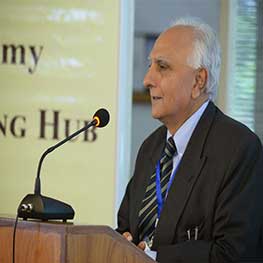Dr. Shahid Amjad Chaudhry
This book emerges from the 17th Annual Conference on the Management of the Pakistan Economy, hosted by the Lahore School of Economics. The Conference has become central to the School's mission to combine academic rigor with practical relevance—encouraging research that addresses Pakistan's evolving economic challenges.
Considering the objectives and timing of this Conference, it is helpful first to step back and assess the current state of Pakistan's economy. While we are all generally familiar with the prevailing conditions, it's essential to understand the complexities unique to managing Pakistan's economy. One significant factor is the 18th Amendment, which shifted substantial responsibilities and financial resources to provincial governments. While this move was correct, it created considerable challenges in managing the federal government's finances.
Historically, governments coming into power often prioritize raising resources or resorting to deficit financing to achieve their political objectives. Due to the federal government's constrained position, Pakistan frequently faces severe fiscal deficits. Recently, a sequence of events led to a significant economic crisis. These included a change in governance, a new political party coming to power, the COVID-19 pandemic, the end of the prolonged flood situation, and subsequent skyrocketing global commodity prices. Together, these events created what can be described as a "perfect storm."
Traditional structures struggled to manage these pressures, leading to an overheated economy and significant exchange rate distortions. Previous governments borrowed excessively, exacerbating the balance of payments crisis. Initial regulatory mechanisms intended to manage demand proved inadequate, and critically, the international community lost confidence in Pakistan's debt management capabilities.
From personal experience as a caretaker and advisor on finance in 2013, I distinctly recall how international partners, including Saudi Arabia and China, made financial assistance conditional upon Pakistan reaching an agreement with the IMF. Consequently, Pakistan's economic stability remains significantly dependent on IMF agreements and endorsements.
The new government initially secured an IMF agreement, but the compounded effects of the earlier "perfect storm" limited its ability to adhere strictly to the agreed constraints. With IMF assistance, however, Pakistan achieved some macroeconomic stability. Nonetheless, significant challenges persist, and this Conference aims to offer insights into managing the current situation.
Some highlighted points include massive exchange rate adjustments, contributing to about half of Pakistan's inflation, as detailed in the paper by Dr. Moazam Mahmood and Dr. Azam Chaudhry and their Modeling Lab. Furthermore, increased commodity prices also played a notable role. These dramatic adjustments in exchange rates and domestic prices have significantly raised poverty levels, with current poverty alleviation measures proving insufficient.
Dr. Rashid Amjad's paper presents intriguing suggestions on the fiscal front, advocating that provincial governments take the lead. In contrast, the federal government assumes a more accommodating role, focusing primarily on managing debt and defense.
Regarding monetary policy, Dr. Naved Hamid argues that the State Bank initially reacted conservatively during the crisis but is now adopting a stringent monetary stance. He advises cautious deliberation before relaxing current policies
Dr. Azam Chaudhry's paper provides important insights regarding foreign investment and trade, highlighting that while exchange rates effectively manage imports, they are less effective for boosting exports. He recommends focusing on expanding existing export categories rather than attempting to introduce entirely new products. Additionally, leveraging comparative advantages may help identify productive policy areas for trade growth.
I want to note a key concern. Despite their size and similar challenges, our neighboring countries have managed their economies effectively, keeping minimal exchange rate fluctuations. One practice that stands out is India's requirement that all external borrowings and export proceeds be fully repatriated and convertible. In contrast, Pakistan has historically allowed more flexibility, which may have unintended negative impacts. Therefore, we should thoroughly examine whether stricter management of foreign borrowings and export proceeds, similar to India's practice, could enhance our economic stability.
By drawing on rigorous analysis and policy experience, this volume seeks to inform both academic discussion and practical policy-making in a moment of economic transition.
Dr. Shahid Amjad Chaudhry Rector
Lahore School of Economics
 Innovation and
Innovation and 